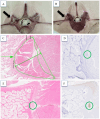Fluoroscopy-guided high-intensity focused ultrasound ablation of the lumbar medial branch nerves: dose escalation study and comparison with radiofrequency ablation in a porcine model
- PMID: 38508592
- PMCID: PMC12128762
- DOI: 10.1136/rapm-2024-105417
Fluoroscopy-guided high-intensity focused ultrasound ablation of the lumbar medial branch nerves: dose escalation study and comparison with radiofrequency ablation in a porcine model
Abstract
Background: Radiofrequency ablation (RFA) is a common method for alleviating chronic back pain by targeting and ablating of facet joint sensory nerves. High-intensity focused ultrasound (HIFU) is an emerging, non-invasive, image-guided technology capable of providing thermal tissue ablation. While HIFU shows promise as a potentially superior option for ablating sensory nerves, its efficacy needs validation and comparison with existing methods.
Methods: Nine adult pigs underwent fluoroscopy-guided HIFU ablation of eight lumbar medial branch nerves, with varying acoustic energy levels: 1000 (N=3), 1500 (N=3), or 2000 (N=3) joules (J). An additional three animals underwent standard RFA (two 90 s long lesions at 80°C) of the same eight nerves. Following 2 days of neurobehavioral observation, all 12 animals were sacrificed. The targeted tissue was excised and subjected to macropathology and micropathology, with a primary focus on the medial branch nerves.
Results: The percentage of ablated nerves with HIFU was 71%, 86%, and 96% for 1000 J, 1500 J, and 2000 J, respectively. In contrast, RFA achieved a 50% ablation rate. No significant adverse events occurred during the procedure or follow-up period.
Conclusions: These findings suggest that HIFU may be more effective than RFA in inducing thermal necrosis of the nerve.
Keywords: Animal Experimentation; Back Pain; Methods; Pain Management; TECHNOLOGY.
© American Society of Regional Anesthesia & Pain Medicine 2025. Re-use permitted under CC BY-NC. No commercial re-use. Published by BMJ Group.
Conflict of interest statement
Competing interests: AH and RA are the founders of FUSMobile and hold ordinary options in the company. J-FA is a member of FUSMobile’s scientific advisory board and holds ordinary options in the company. SL and EM hold shares and ordinary options in the company. SM holds ordinary options in the company. MG holds ordinary options in the company and is a consultant to the company. TT has no interests to declare.
Figures




Comment in
-
High-intensity focused ultrasound as the savior for lumbar facet joint neurotomy: fact, fad, or fiction?Reg Anesth Pain Med. 2025 Apr 10;50(4):321-323. doi: 10.1136/rapm-2024-105515. Reg Anesth Pain Med. 2025. PMID: 38724269 No abstract available.
References
Publication types
MeSH terms
LinkOut - more resources
Full Text Sources
